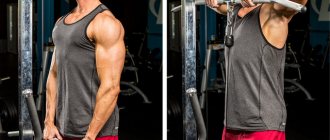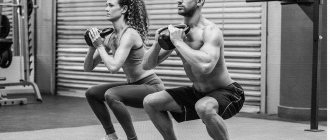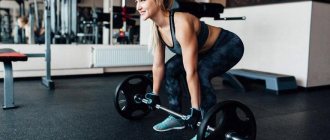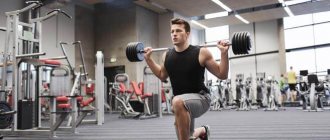Split training (English split - to split, split) is a method of constructing sports activities, which involves dividing the training program into parts and performing them on different days. This principle is used in bodybuilding and helps the athlete to load the necessary muscles well in a short period of time.
Advantages of the technique:
- Accented elaboration . Each lesson is aimed at developing a selected muscle group, which allows you to gradually increase weight loads.
- Optimal rest . Thanks to the separate principle, the risk of overtraining is reduced, and the muscles have enough time to recover.
- Increasing the intensity of classes . Using the split method, the athlete gets the opportunity to conduct short but effective workouts.
The use of split programs contributes to the development of strength characteristics and stimulates hypertrophy of muscle fibers.
Difference from other methods
Let's look at two popular training systems and compare them with splits.
Full body
Whole body workout. It is a program in which each session is aimed at developing the main muscle groups.
The advantages of the technique include comprehensive strengthening of the muscles and ligaments of the body.
The disadvantages are that they are not suitable for volumetric strength training.
The difference between the systems: thanks to the accentuated training of muscles and a long recovery period, split training for mass, in contrast to the “full body”, allows the athlete to gradually increase the load each session, stimulating the muscles to grow.
Experienced fitness trainers recommend full body to beginner athletes in order to strengthen the muscle frame and ligaments and prepare the body for more serious loads. And, conversely, trained athletes and professionals engage in separate split training.
Circuit training
It is based on intense exercises performed in a circle, with minimal breaks. Circuit training is recommended for those who want to have a toned, functional body with minimal body fat.
The technique is designed to increase endurance and lose weight.
Cyclic exercises allow you to harmoniously strengthen your muscles.
The downside of such training and the main difference from split training is the inability to build large muscle volumes and strength.
Beginners and girls can start with low-intensity circuit exercises so as not to overload the heart muscle. Professional athletes, as a rule, use such training to work out the relief and reduce subcutaneous fat.
Relax more
Stress puts excessive stress on the body and nervous system, slowing down the recovery process after exercise. Try to engage in stress-busting activities whenever possible.
.
Get a massage, do meditation, go for a walk in the forest, listen to soothing music and simply learn to detach yourself from the world around you.
If you are not following an appropriate diet, then taking supplements is a waste of money.
No matter how strange it may sound in the context of an article about a training program for gaining muscle mass, it is better to spend money on quality meat than on a package of protein.
If everything is in order with your nutrition, then the following supplements will definitely benefit you and your muscles.
Pre-workout supplements
Here you have your choice, but not everyone needs them. The best pre-workout option is any complex without an excessive amount of stimulants.
Protein
Whey protein is considered by many athletes to be the best supplement for muscle growth. Since it contains a full set of amino acids and is absorbed quite quickly. The cocktail can be taken immediately after training, as well as in the morning. And if there is not enough protein in your diet, you can drink one serving between meals. Whey protein is one of the best sports supplements that has proven its effectiveness.
BCAAs
This supplement consists of three amino acids leucine, isoleucine and valine, it protects muscle fibers from destruction by cortisol. It can be taken before, during or after training. It all depends on what kind of food you had before classes and how long ago it was.
Creatine
A truly high-quality supplement for gaining mass and strength. Improves endurance and speed of recovery of the body. Perfect for intense weight training.
Recommendations for different body types
Read more about this classification in a separate material on somatotypes.
Ectomorph
Thin people with thin bones, underdeveloped muscle corset and low subcutaneous body fat:
- Nutrition . To gain weight, you need a high-calorie diet (more than 3300 kcal/day). The basis of the menu should be “complex” carbohydrates: cereals, durum wheat pasta, whole grain bread. Proteins and fats should be consumed in approximately equal proportions. You need to eat several times a day. If you can’t increase your body weight, you can use sports nutrition: creatine, gainers.
- Physical exercise . For ectomorphs, it is not advisable to get involved in aerobic training. Classes should be based on basic elements (deadlift, bench press, squat). Exercises should be distributed over 3 sessions per week, that is, the preferred type of training for the ectomorphic type is a three-day split with pauses of 1-2 days.
Mesomorph
Physically developed, strong people, most predisposed to strength training:
- Nutrition . The basis of a mesomorph’s diet should be protein foods: red meat, poultry, fish, cottage cheese. Menu calorie content: 3200–3400 kcal/day. People with a mesomorphic body type need to reduce carbohydrates and fats in their diet. Recommended supplements: vitamins, protein mixtures.
- Physical exercise . The basis of mesomorph training is the same strength elements: squats, bench presses, deadlifts. Exercises should be divided into 3 sessions. At the same time, a three-day split training for men should be strength training, that is, in each approach you need to select the weight so that failure is felt at 7-8 repetitions. In addition to the basic elements, you should select “complementary” exercises that promote maximum blood supply to the muscles. Rest between classes - 1-2 days.
Endomorph
Large-boned people with a high percentage of subcutaneous fat and weak, undeveloped muscles:
- Nutrition . The diet should be divided into small portions. Low calorie content: no more than 1800 kcal/day. The basis of the menu should be lean proteins (chicken fillet, eggs without yolks, fish, low-fat cottage cheese) and vegetable fiber (fruits, vegetables, herbs). The amount of carbohydrate food should be reduced to 15% of the daily value. Recommended supplements: vitamins, fat-burning complexes, high-quality protein isolates.
- Physical exercise . The training program should be drawn up for three days a week. It is recommended that these classes be carried out in an aerobic mode, aimed at burning fat and tightening the body (for example, aerobics, circuit training). If an athlete wants to train using the split method, the weights should be selected so that the approaches are multi-repetitive (15–20 times). The break between classes is 1 day. During recovery periods, you can do cardio exercises outside (for example, cycling or a light jog in the park).
As a rule, mixed body types predominate among people, for example, ectomorph-mesomorph. To more accurately determine your body type and create an effective training program, we recommend contacting a professional fitness trainer.
By the way, split training for girls is not much different from men’s; adjustments are made only for the weight of the equipment.
Timing
A beginner needs more time to recover from strength training, and the body should smoothly enter an unusual mode for it, for which it will later be grateful.
Therefore, a beginner starts with training 2-3 times a week. Further, the number of classes and their timing can be adjusted in both directions. Nobody canceled the assessment of the volume of work done. As a rule, beginner athletes train for 45-60 minutes, including warm-up and cool-down time. Professional athletes can exercise daily, but one day a week must be set aside for rest.
Two-day split
The technique is suitable for all interested athletes who do not use anabolic steroids. It is known that muscles grow in volume with a constant increase in weight loads and quality rest. But many athletes, having read “programs from champions” on the Internet, try to repeat the success of bodybuilding stars, completely forgetting that all professionals use expensive pharmacological support.
Naturally, the “natural” muscles do not have time to recover from such training, and the results leave much to be desired. Therefore, experienced mentors recommend that everyone who practices “purely” use two-day splits. These programs allow you to get quality rest between workouts, which has a positive effect on increasing strength and mass.
Principles of compilation:
- All muscles should be divided into two large groups.
- Exercises that load the muscles of the back and lower back should be spread out on different days.
- Elements that create stress on the shoulder joints should also be distributed among individual workouts.
Example program
1 lesson:
- Pull-ups on the bar: 3x10.
- Head pull in the simulator: 3x15.
- Deadlift: 3x8.
- Crossover waist pull: 3x15.
- Abduction in the butterfly machine: 3x10.
- Seated chest press: 3x10.
- Dumbbell lateral raises: 3x12.
- Close grip barbell press: 2x8.
- French press: 2x12.
Lesson 2:
- Barbell squats: 3x8.
- Lunges with an empty bar on the shoulders: 2x10.
- Calf raises: 3x20.
- Bench chest press: 3x8.
- Dips: 2x12.
- Mixing in a butterfly simulator: 3x12.
- Dumbbell raises on a horizontal bench: 3x10.
- Curling arms in the Scott machine: 3x12.
- Crossover biceps curl: 3x15.
Work your abdominals at the end of your workouts. The pause between classes is 2–3 days.
Three day split
The most common scheme. The 3-day split is used by both beginners and professionals. With this type of training, the muscles receive an accentuated load and sufficient time for recovery.
Principles:
- Basic elements are distributed over three workouts.
- In addition to strength training, the plan includes “finishing” exercises.
Example program
1 lesson:
- Bench press: 4x8.
- Mixing in a butterfly simulator: 3x12.
- Dips: 3x10.
- Lying crossover raise: 3x10.
- Incline chest press: 3x10.
- French bench press: 3x12.
- Crossover triceps extension: 3x12.
- Reverse push-ups from a bench: 3x12.
Lesson 2:
- Pull-ups on the bar: 4x8-10.
- Head pull while sitting in a crossover: 3x12.
- Deadlift: 3x8.
- Bent-over dumbbell raises: 2x10.
- Chest row with a wide grip on the lower block: 3x12.
- Crossover biceps curl: 3x12.
- Hammer grip dumbbell curls: 2x12.
- EZ-bar biceps curl: 3x12.
Lesson 3:
- Squats: 4x8.
- Hack squats: 3x10.
- Extension in the quadriceps machine: 2x12.
- Lying flexion in the hamstring machine: 2x12.
- Raises in the calf machine: 3x20.
- Smith overhead press: 3x10.
- Standing dumbbell press: 3x10.
- Wide grip barbell row to the chin: 3x10.
Strengthen your abdominal muscles at the end of the session. Between workouts, leave a free day for rest.
Four-day split
This type of training is used by trained athletes when it is necessary to increase the intensity of training. It is not recommended for beginners to practice this split.
The method is based on the same division of large muscle groups and working them on separate days. There are no fundamental differences from the three-day program. One workout is simply added, into which part of the exercises performed is distributed, for example, for the shoulders and arms.
The schedule can be drawn up in different ways, but the most popular scheme is: Monday, Tuesday - training; Wednesday - break; Thursday, Friday - training; Saturday, Sunday - rest.
Example program
Monday:
- Wide pull-ups: 3x10–12.
- Deadlift: 3x10.
- Hyperextensions: 3x12.
- Bent-over barbell row from the floor: 3x10.
- Shrugs with dumbbells: 3x12.
Tuesday:
- Push-ups: 2x12.
- Bench press: 3x10.
- Crossover wiring: 3x12.
- Smith Incline Press: 3x12.
- Push-ups: 3x12.
Thursday:
- Barbell squats: 3x10.
- Hack squats: 3x12.
- Bulgarian lunges: 3x12.
- Hamstrings in the machine: 3x12.
- Working out the calves in the machine: 3x20.
Friday:
- Narrow chest press in Smith: 3x12.
- Reverse grip pull-ups: 3x10–12.
- Military seated press: 3x12.
- Smith overhead press: 3x12.
- Breeding in the “butterfly” simulator: 3x12.
Work your abdominal muscles at the end of each session. Before the basic elements, perform warm-up approaches.
Split for the endomorph
People who tend to be overweight from a very early age fall into this category. Gaining weight is not a problem for them, which lingers mainly on the stomach and hips, while worsening the appearance of the shoulders and chest.
Basic Rules
⇒ basic exercises that involve a large number of muscles burn calories faster while simultaneously improving muscle shape;
⇒ rest between approaches no more than 1-1.5 minutes;
⇒ training duration increases to 1.5 hours; due to heavy weights, you need to rest longer;
⇒ the number of repetitions is 15-12, and the approaches are from 3 to 6.
Training complex
Five day split
The most effective option for dividing exercises. It is intended only for trained athletes who have experience training in three- and four-day programs.
The principle of construction is to work out each major muscle group on a separate day. When drawing up a training plan, you should correctly distribute the loads so as not to overtrain any part of the body. For example, after working out the chest, it is not recommended to do a shoulder exercise the next day, since all kinds of presses for the pectoral muscles actively involve the anterior and middle deltoids.
Example program
Monday - back:
- Deadlift: 3x8.
- Bent-over dumbbell rows: 3x12.
- T-bar lift: 3x10.
- Shrugs with dumbbells: 3x12.
- Hyperextensions with weights: 3x12.
Tuesday - chest:
- Classic bench press: 3x8.
- Dips: 3x12.
- Incline dumbbell press: 3x12.
- Wiring on a horizontal bench: 3x12.
- Wide push-ups from platforms: 3x12.
Wednesday - legs:
- Barbell squats: 3x8.
- Leg press in the simulator: 3x10.
- Lunges with a small bar on the shoulders: 3x12.
- Romanian deadlift: 3x10.
- Standing calf raises: 3x20.
Thursday - shoulders:
- Military bench press: 3x10.
- Smith overhead press: 3x12.
- Lifting dumbbells in front: 3x12.
- Wiring across the sides: 3x12.
- Bent over raises: 3x12.
Friday - hands:
- Close grip bench press: 3x12.
- Scott curls: 3x12.
- French bench press: 3x12.
- Crossover biceps curl: 3x12.
- Dips (elbows - narrow): 3x12.
Work your abdominal muscles 3-4 times a week. To make the split easier, you can move your Saturday rest to Wednesday.
Option B
And another 3-day training program. The second option is more designed to develop strength qualities.
Day 1
- Cardio and warm-up.
- Hyperextension: 2 to 15.
- Deadlift: 5 sets of 5 reps and a sixth set of 60% of the working weight for 15 reps.
- Bench press: 5 x 5 with heavy weight, but not maximal.
- Biceps hammer: 2 x 10.
- Abs: 2 x 2 hanging leg raises with weights and 2 x 10 Roman chair crunches with a dumbbell.
Day 2
- Cardio and warm-up.
- Bench press: 3 x 5 and 2 x 3 with maximum weights.
- Hammer chest press: 3 x 8-10 with maximum weights.
- Crossover raises, dumbbell raises lying on a horizontal bench with supersets: 2 x 10 and 2 x 10 (alternate 1 set of raises with 1 set of raises).
- Extension of arms on a block: 3 x 10, 1 x 8, 1 x 6, 1 x 4 - we make a “ladder” with increasing weights. You must push yourself to the limit for the last 2 reps of each set using proper technique.
- Abs: Roman chair crunches 3 x 10 with weight.
Day 3
- Cardio and warm-up.
- Barbell squats: 5 to 5.
- Leg press: 3 x 8–10.
- Lat pulldowns or pull-ups with a narrow reverse grip: 4 to 8 with weights.
- Pullover: 2 to 10.
- Cardio: 15 minutes with 1 interval.
You can remove the deadlift and replace it with the leg press. It all depends on your physical capabilities.
Although indirect, but which interests the muscle a little. People tend to do more to build as much muscle mass as possible. Unfortunately, the system does not work in strength training. Muscles need sufficient time to recover. If this is not given, you will achieve the opposite. Your muscles don't grow, they stagnate. You can no longer increase your weights and therefore cannot make any progress. This stagnation is often referred to as "overtraining."
If we look at this from a scientific point of view and fix the frequency of training based on protein biosynthesis, then we conclude that approximately 3 times a week seems to be optimal. Since synthesis increases within 24 hours to 72 hours after exercise, this would be a sign that you need to attack the muscle several times a week. You shouldn't be looking to attack your muscles multiple times a week now with your 3, 4, 5 or even 6 split. This will result in at least twice as many training sessions.
Isolated exercises should be eliminated. You can change various auxiliary elements every 2 weeks, for example, bringing your arms together in a crossover to pressing dumbbells upside down, or lunges with dumbbells to straightening and bending your legs in a machine.
A two-day mass training program will be very different from the ones above, because the whole body needs to be worked out in 2 days. At the same time, you should not excessively delay the duration of classes.
Research on protein biosynthesis is hidden behind this link. Of course, the general training frequency of 3 training sessions per week does not apply to every athlete. Facilitates regeneration by training light circulation, sauna or shower showers, can train again and thereby increase the frequency of training in the air. Highly skilled people who have been actively involved in sports for several years may also recover faster.
It's much better to see how quickly your muscles regenerate.
Do you need to be efficient again? Typically this is about 48 hours. If you are training on Monday evening, then it is recommended to work the same muscle group on Wednesday evening and then again on Friday evening.
The training program for girls, if they also want to gain weight, will look about the same.
Both training programs are aimed at developing muscle mass and strength.
Recommendations for beginners
These tips will help inexperienced athletes get the maximum benefit from their training:
- Don't start bodybuilding straight away with splits. Prepare your muscles and ligaments with circuit training.
- Do not copy the programs of famous athletes. Choose your plan based on your physical fitness and body type.
- Don't overdo isolation exercises. Additional elements do not replace the basic ones.
- Keep an eye on your technique. It is not always possible to increase the load with each workout. It is better to perform the approach with the weight of the previous lesson, but technically correct.
- In the first months of training, do not push your muscles to the limit. Complete the approach before failure occurs.
- Do not delay the duration of the lesson. 50–60 minutes is enough to effectively load the target muscles.
While in the gym, monitor how you feel. If you feel a strong stretch or even more acute pain in the joint, discard the element and replace it with a safe analogue.











